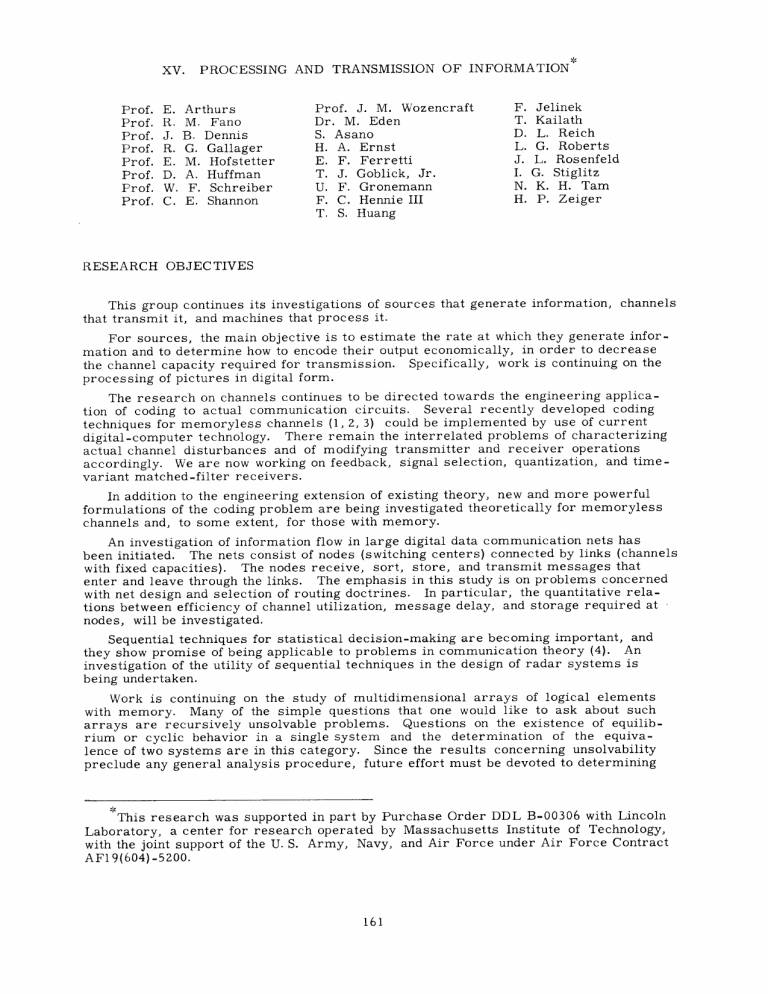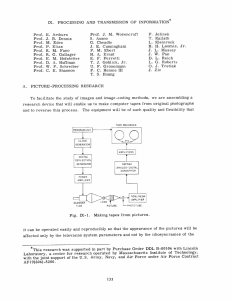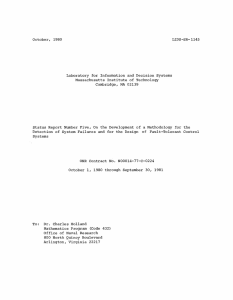AND TRANSMISSION OF INFORMATION XV. PROCESSING F. Jelinek

XV. PROCESSING AND TRANSMISSION OF INFORMATION
Prof. E. Arthurs
Prof. R. M. Fano
Prof. J. B. Dennis
Prof. R. G. Gallager
Prof. E. M. Hofstetter
Prof. D. A. Huffman
Prof. W. F. Schreiber
Prof. C. E. Shannon
Prof. J. M. Wozencraft
Dr. M. Eden
S. Asano
H. A. Ernst
E. F. Ferretti
T. J. Goblick, Jr.
U. F. Gronemann
F. C. Hennie III
T. S. Huang
F. Jelinek
T. Kailath
D. L. Reich
L. G. Roberts
J. L. Rosenfeld
I. G. Stiglitz
N. K. H. Tam
H. P. Zeiger
RESEARCH OBJEC TIVES
This group continues its investigations of sources that generate information, channels that transmit it, and machines that process it.
For sources, the main objective is to estimate the rate at which they generate information and to determine how to encode their output economically, in order to decrease the channel capacity required for transmission. Specifically, work is continuing on the processing of pictures in digital form.
The research on channels continues to be directed towards the engineering application of coding to actual communication circuits. Several recently developed coding techniques for memoryless channels (1, 2, 3) could be implemented by use of current digital-computer technology. There remain the interrelated problems of characterizing actual channel disturbances and of modifying transmitter and receiver operations accordingly. We are now working on feedback, signal selection, quantization, and timevariant matched-filter receivers.
In addition to the engineering extension of existing theory, new and more powerful formulations of the coding problem are being investigated theoretically for memoryless channels and, to some extent, for those with memory.
An investigation of information flow in large digital data communication nets has been initiated. The nets consist of nodes (switching centers) connected by links (channels with fixed capacities). The nodes receive, sort, store, and transmit messages that enter and leave through the links. The emphasis in this study is on problems concerned with net design and selection of routing doctrines. In particular, the quantitative relations between efficiency of channel utilization, message delay, and storage required at nodes, will be investigated.
Sequential techniques for statistical decision-making are becoming important, and they show promise of being applicable to problems in communication theory (4).
An investigation of the utility of sequential techniques in the design of radar systems is being undertaken.
Work is continuing on the study of multidimensional arrays of logical elements with memory. Many of the simple questions that one would like to ask about such arrays are recursively unsolvable problems. Questions on the existence of equilibrium or cyclic behavior in a single system and the determination of the equivalence of two systems are in this category. Since the results concerning unsolvability preclude any general analysis procedure, future effort must be devoted to determining
This research was supported in part by Purchase Order DDL B-00306 with Lincoln
Laboratory, a center for research operated by Massachusetts Institute of Technology, with the joint support of the U. S. Army, Navy, and Air Force under Air Force Contract
AFI 9(604)-5200.
161
(XV. PROCESSING AND TRANSMISSION OF INFORMATION) the logical capabilities of different types of multidimensional systems, and to developing practical techniques for their synthesis. Useful synthesis techniques will also require a better understanding of the nature of the transient process in both one- and twodimensional systems.
E. Arthurs, R. M. Fano, J. M. Wozencraft
References
1. R. G. Gallager, Low Density Parity Check Codes, Sc. D. Thesis, Department of Electrical Engineering, M. I. T. , 1960.
2. B. Reiffen, Sequential Encoding and Decoding for the Discrete Memoryless Channel, Technical Report 374, Research Laboratory of Electronics, M. I. T. , August 12,
1960.
3. W. W. Peterson, Error-Correcting Codes (Technology Press of Massachusetts
Institute of Technology, Cambridge, Mass., and John Wiley and Sons, Inc., New York,
1961).
4. E. M. Hofstetter, Large-Sample Sequential Decision Theory, Technical
Report 359, Research Laboratory of Electronics, M. I. T. , Dec. 9, 1959.
162










